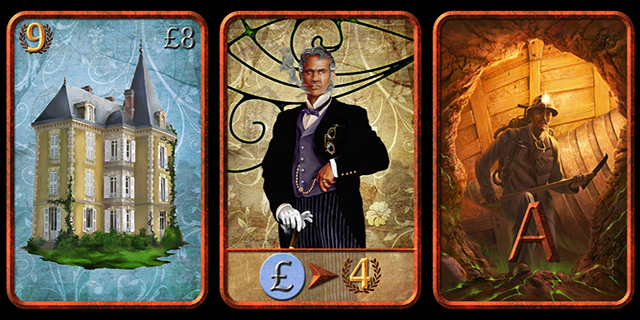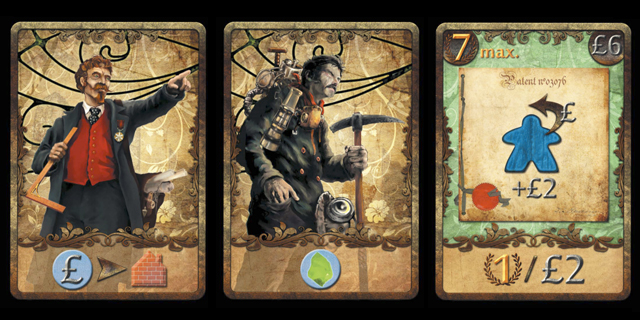 Worker placement is a recurring mechanic in a lot of modern board games. One of the very first games to use this mechanic was Caylus, designed by William Atta almost ten years ago. Nearly a decade after his debut creation, Atta has returned to the worker placement mindspace and turned it into Spyrium with some unique modifications.
Worker placement is a recurring mechanic in a lot of modern board games. One of the very first games to use this mechanic was Caylus, designed by William Atta almost ten years ago. Nearly a decade after his debut creation, Atta has returned to the worker placement mindspace and turned it into Spyrium with some unique modifications.
In Spyrium, each player begins with a handful of pounds, three workers and two pieces of the eponymous green mineral. A field of nine cards are laid out in a three-by-three grid in each of the game’s six rounds, along with one special action card that will change each round. Every round is divided into two phases, but not at any set time. One of the many strategic choices that players will have to make is when to shift themselves from Phase One to Phase Two.
Phase One is basically the worker placement phase. A player may place one of their available workers in the space between any two cards in the grid. They will not get any benefit from doing so until Phase Two, but positioning and timing is important here. Instead of placing a worker, a player may instead use the round’s special action (once per round) or shift to Phase Two, at which point they immediately take a Phase Two action.
Workers can be retrieved in Phase Two, selecting one of the cards neighboring that worker for one of two benefits. Buildings can be purchased and constructed, with the player paying an additional “lot fee” for every building they erect beyond their first; players have the option to overbuild an existing building to avoid this fee, and might even earn a discount depending on the buildings in question. Patents can also be purchased, giving the player a special ability for the rest of the game as well as offering bonus points (up to seven) at the end of the game.
The final type of card are personalities, which give a one-time benefit but are not removed from the grid when activated. Personalities often have tokens with values from one through three placed on them when dealt out; these tokens affect the personality’s cost or reward and add an extra element of timing to what is already a virtual game of chicken.

The devious twist here, and Spyrium‘s defining mechanic, is that the cost a player pays to purchase or activate a card is increased by one pound for every other worker bordering that card (including their own). Highly-desired cards will cost you dearly if you take them too early, but if you don’t then they might not be there to take later! Placing a worker to artificially inflate the cost of a competitor’s desired card is a common tactic, and a potentially lucrative one as well.
If you don’t want (or can’t) pay for a card when you retrieve a worker, you may instead select one of its neighboring cards and collect one pound for every other worker remaining around that card. Of course, you are also making that card less expensive for the person who finally decides to pay for it, if any. This strategic dance is fascinating, as you constantly have to weigh the value of each worker against your future plans and your present cash situation. Also worth noting is that if a worker has both of its neighboring cards removed before being reclaimed, that worker is worthless and generates no cash.
In addition to reclaiming workers and using the round’s special action (if you didn’t in Phase One), Phase Two is also when you can use buildings you have constructed. Mines produce spyrium, and factories turn spyrium into victory points. Some buildings either require or provide the option of using unplaced workers when activating them for a larger benefit, so keeping some in reserve during Phase One can pay off later. Other buildings provide additional workers to your pool, increase your income each round, or let you use workers to generate points without needing spyrium. Most buildings are also worth points at the end of the game, although any that you have replaced for lot purposes are obviously not counted.

Playing Spyrium is all about managing your extremely limited resources in the most efficient manner. You only have so many workers that need to be used in a variety of ways, and cash is especially tight while you get your footing in the early rounds. Grabbing an early patent can help define your strategy, giving you an edge that your opponent’s don’t possess as well as a source of additional points. Establishing some sort of engine is crucial, but the random nature of each round’s card layout can seriously impact your ability to plan long-term. Adaptability is key.
I really like the way Spyrium offers so many options without one being blatantly better than the others. With every worker placed or removed, the situation changes. Your choices between actions can be completely different from what they were on your previous turn. When to place, where to place, when to not place, when to remove, when to shift gears… every choice has to be weighed carefully, and acting too soon or too late can be costly.
Spyrium supports from two to five players, although I can’t imagine that a two-player game would be that enjoyable. Depending on the number of players a game can take as much as 90 minutes, with most games coming in at around an hour or so. There is no actual in-game text, but cards like patents and personalities might have to be referenced in the rules until everyone knows what they do.
Spyrium retails for $35.



















